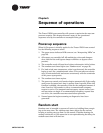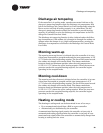
Chapter 5 Sequence of operations
36 CNT-SVX07C-EN
Occupancy modes
Occupancy modes can be controlled by any of the following:
• The state of the local (hard-wired) occupancy binary input BI3 (see
“BI3: Occupancy or generic binary input” on page 15)
• A timed override request from a Trane zone sensor (see “Timed over-
ride control” on page 37)
• A communicated signal from a peer device (see “Peer-to-peer commu-
nication” on page 48)
• A communicated signal from a BAS
A communicated request, either from a BAS or a peer controller, takes
precedence over local requests. If a communicated occupancy request has
been established and is no longer present, the controller reverts to the
default (occupied) occupancy mode after 15 minutes (if no hard-wired
occupancy request exists). The Tracer ZN521 has the following occupancy
mode options:
• Occupied
• Unoccupied
• Occupied standby
• Occupied bypass
Occupied mode
In occupied mode, the controller maintains the zone temperature based
on the occupied heating or cooling setpoints. The controller uses the occu-
pied mode as a default mode when other forms of occupancy request are
not present. The fan will run as configured (continuous or cycling). The
outdoor air damper will close when the fan is off. The temperature set-
points can be local (hard-wired), communicated, or stored default values
(configurable using the Rover service tool).
Unoccupied mode
In unoccupied mode, the controller attempts to maintain the zone temper-
ature based on the unoccupied heating or cooling setpoint. The fan will
cycle between high speed and off. The outdoor air damper will remain
closed, unless economizing. The controller always uses the stored default
setpoint values (configurable using the Rover service tool), regardless of
the presence of a hard-wired or communicated setpoint value.
Occupied standby mode
The controller is placed in occupied standby mode only when a communi-
cated occupied request is combined with an unoccupied request from
occupancy binary input BI3. In occupied standby mode, the controller
maintains the zone temperature based on the occupied standby heating
or cooling setpoints. Because the occupied standby setpoints are typically
spread 2°F (1.1°C) in either direction and the outdoor air damper is
closed, this mode reduces the demand for heating and cooling the space.


















